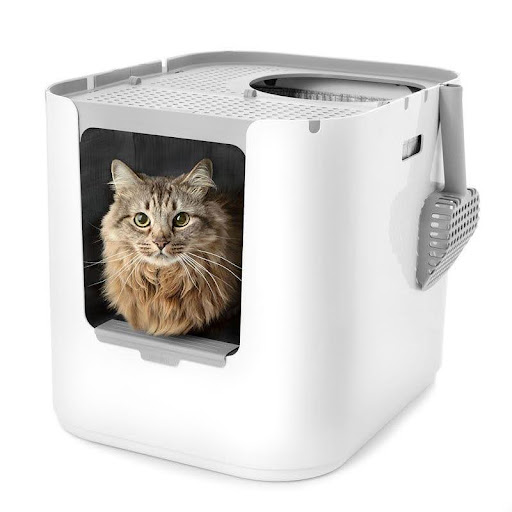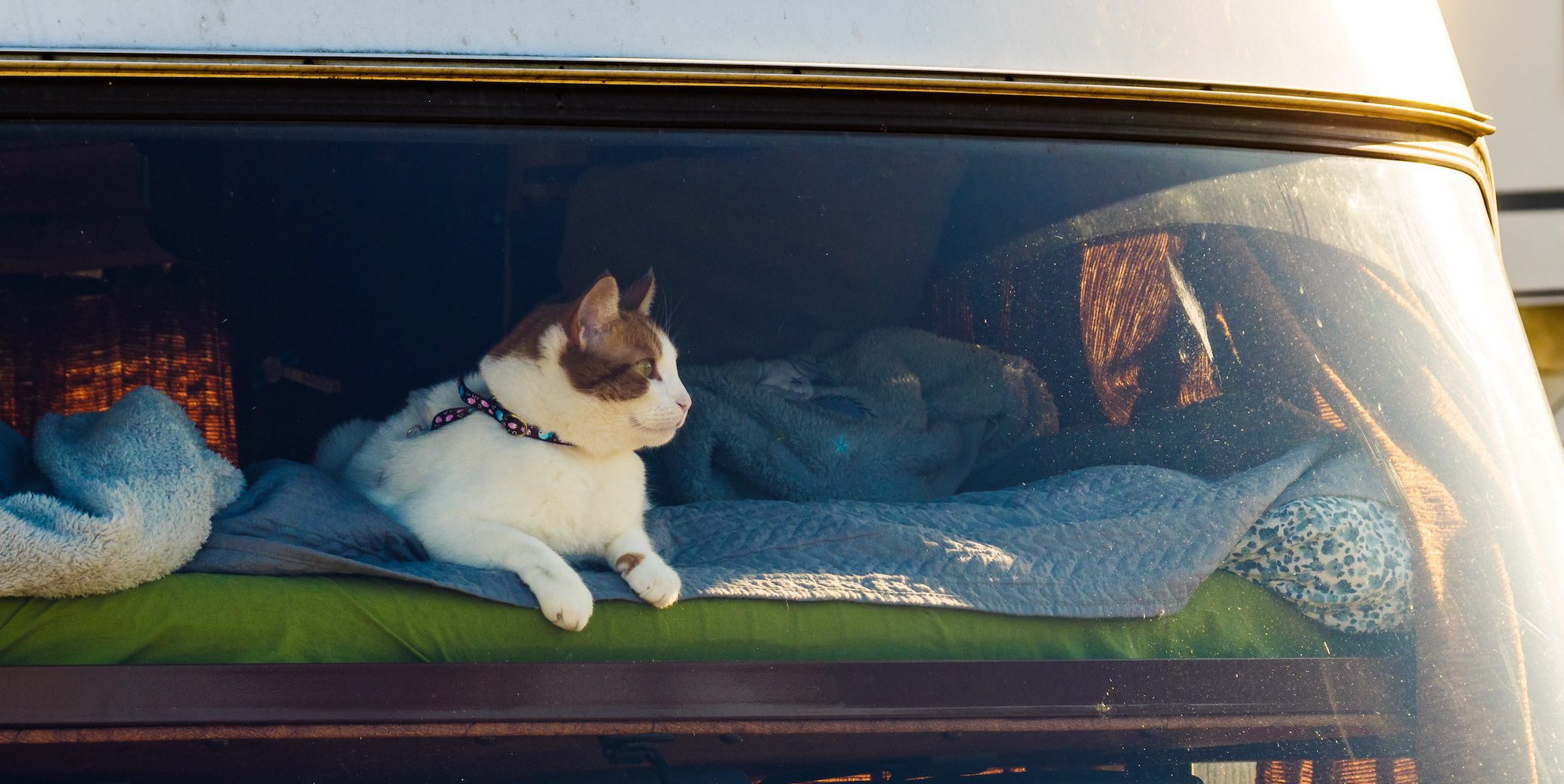Taking a feline friend on the open road can be a wonderful experience. Everyone assumes that dogs love RV travel. (And, of course, RV dogs have their own needs.) But cats accustomed to RV life can also be purrfect traveling companions. What’s more, many actually love joining their humans for road trip adventures. Cats that are familiar with the RV enjoy taking in the new sights, sounds, and scents from the comfort of their home on wheels. However, just like humans, cats have specific needs that must be met to ensure a safe and comfortable RV life. And there are certain RV cat accessories that a feline friend simply can’t do without.
So, if you’re thinking about taking your cat on the road for the first time, we’ll give you the skinny on the five RV cat accessories that are absolute must-haves.
1. Identification: Microchip and a Collar with ID Tags

As you might expect, it’s always best to keep cats safe inside the RV. Keeping them inside will eliminate the hazards presented by predators, vehicles, and other dangers. (Especially in the strange and unfamiliar environment of an RV park or campground.)
However, you can (and should) provide a second line of defense for your feline friend by having your cat microchipped by your vet — and having them wear two identification tags on a well-fitted collar. One ID tag, like this one on Etsy, should have his name and your phone number. The other tag can be a small writable tag on which you can write your campground with your campsite address. Having ID on your cat can be a lifesaver if they happen to make a quick (and inevitably sneaky) exit from the RV.
2. A Familiar Litter Box with the Same Kitty Litter

Most cats do best in the RV with familiar items. Be sure to pack their favorite food and water dishes along with the food they know and love. Also, it’s also a good idea to set up the litter box with same the kitty litter he has at home. You can prevent potential messes in the RV by setting it up on a litter mat.
3. An Oversized Carrier They’re Comfortable In
The safest way for your cat to travel is in a kennel that’s inside the vehicle with you. (It goes without saying that no one should be inside the trailer while it’s moving, including your kitty.) In addition, it’s always safest for your cat to ride in a travel kennel that’s big enough for them to move around in. Not only does a kennel provide a safe, familiar place for your cat. It also provides an easy means of locating your pet should you be involved in an accident.
With that being said, cat carriers are tiny, because they’re designed for short trips to the vet, not for spending hours in. Instead of a cat carrier, consider setting your cat up with a travel crate designed for a medium size dog. Be sure to outfit it with his favorite bedding and toys. The idea is to make it into a space he loves being in.
On that note, be sure to train your cat to love his travel kennel before he goes anywhere in it. You’ll need to familiarize him in three stages: With the door open, with the door closed, and going on short trips in the crate.
Remember: Always work within your cat’s comfort zone. The goal here is to have your cat run into the crate on cue or whenever he wants to feel safe and cozy. Rushing the process can lead to a permanently bad association with the crate.
How To Kennel Train Your Cat
- Make the crate irresistibly comfy. Start by lining it with familiar bedding. Add some favorite toys. Maybe even a little catnip and some of their favorite kitty treats. At this stage, don’t try to get them into the crate. (You want them to think it’s all their idea.)
- Feed them near the crate. Start by feeding your cat close to the crate with the door open. Do this for up to a week, until you can see he is more curious about the crate than worried about it, perhaps even going into the crate on his own.
- Sneak the food into the crate. Now you can up the ante by putting his food dish just inside the door of the crate. Feed a few meals this way and gradually move the dish further back in the crate an inch or two at a time.
- Make it fun. In the meantime, start playing a game with your cat. Toss a treat into the crate, and when he goes in to get it, say “Kennel!” and quickly toss another one in.
- Casually close the door. When your cat is obviously comfortable going into the crate, perhaps running in at the mere mention of the word “kennel!” It’s time to close the door, briefly at first because your work will be undone if he thinks he’s been tricked and is now trapped in the kennel.
- Extend the time. Gradually extend the period of time your cat spends in the kennel, working gradually towards 10 minute periods.
Transitioning to Your RV
- Look for the sign. When your cat really wishes you’d stop opening the door to the crate, it will be time to take this show on the road.
- Try a short drive. Secure the crate with cat in it into the tow vehicle or motorhome, and go for a short drive. This should be 15 minutes or less.
- Make a maiden voyage. When your cat is completely comfortable riding in the vehicle, he should be ready for his first RV adventure.
4. A Small Post for Legal Scratching
Clawing and scratching objects is a natural feline behavior. However, you can prevent your cat from using his claws to damage your RV furniture by providing him with a “legal” way to express his instinctive scratching behavior. Giving your cat a small scratching post in the RV can help him to feel at home in the RV — while saving your RV furniture.
5. A Comfy, Cozy Perch for Cat Naps

Cats appreciate a comfortable spot with a nice view just as much as we do. From a cat’s point of view, what could be better than a comfortable bed that mounts directly on an RV window, perfect for bird watching or just keeping tabs on his kingdom.
Beyond RV Cat Accessories: A Few Road Tips
Cats learn to love RV travel when it’s introduced slowly, and they’re surrounded with the familiar items they have at home. But having the right RV cat accessories isn’t your only key to success. Here are a few other tips and tricks that are handy to know when traveling with your cat.
- Careful with the slide-outs. Be sure all cats are in their carriers before bringing slide-outs in. Cats can fit into tiny spaces, and it can be difficult to crate them after the slide-out comes in. Not only that, but there is a chance your cat could be injured if they don’t get out of the way of the slide-out.
- Add kitty breaks. Give your kitty frequent breaks when you’re traveling so they can have all the access they need to food, treats, water and his litter box.
- Control the climate. Use a bluetooth enabled temperature monitoring system if you need to be away from the RV for an extended period.

Leave a Reply